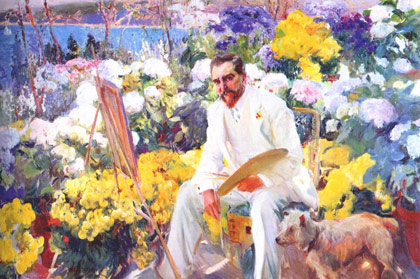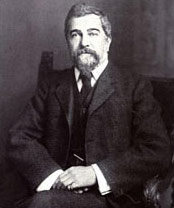History of Tiffany Lamps
- Home
- History
History of Tiffany Lamps & Lampshades
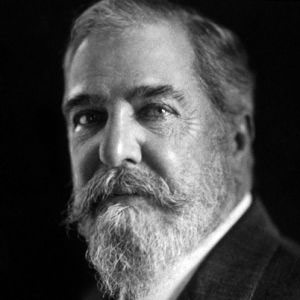 Louis Comfort Tiffany, the son of Charles Lewis Tiffany, began his career as a painter in the 1860s and 1870s. After studying under the American landscape painter George Inness, Tiffany combined the use of light, color and nature in his work. He received praise for his oils and watercolors, which included scenes from his travels in Europe and North Africa. By 1880, Tiffany had established himself as a artist and became the youngest member of the National Academy of Design. Tiffany’s travels not only influenced his career but also acquainted him with the designs of medieval and Roman glass. Glass would offer a new field of challenge for Tiffany and would lead him to his next endeavor in design and decorative arts as an interior designer. His commissions for Mark Twain, Cornelius Vanderbilt and the White House under President Arthur earned him an international reputation and great success. Stained-glass windows were a feature in these interiors.
Louis Comfort Tiffany, the son of Charles Lewis Tiffany, began his career as a painter in the 1860s and 1870s. After studying under the American landscape painter George Inness, Tiffany combined the use of light, color and nature in his work. He received praise for his oils and watercolors, which included scenes from his travels in Europe and North Africa. By 1880, Tiffany had established himself as a artist and became the youngest member of the National Academy of Design. Tiffany’s travels not only influenced his career but also acquainted him with the designs of medieval and Roman glass. Glass would offer a new field of challenge for Tiffany and would lead him to his next endeavor in design and decorative arts as an interior designer. His commissions for Mark Twain, Cornelius Vanderbilt and the White House under President Arthur earned him an international reputation and great success. Stained-glass windows were a feature in these interiors.
Tiffany became an enthusiastic supporter of the European Art Nouveau movement, challenging the current Victorian ornate style. Art Nouveau used free-flowing designs based on nature that exemplified the characteristics prevalent in Tiffany’s earlier creations as a landscape painter. The use of light, color and nature assumed greater significance in Tiffany’s work as he developed his unique approach to Art Nouveau.
In an effort to reach the interiors of a greater population, Tiffany began to design lamps to allow more people to enjoy art and beauty in their own home. Colored glass, Tiffany’s lasting love and challenge, found fresh scope and inspiration. While the windows served to transmit the light of day, the lamps represent a new source of illumination independent of daylight. Fabrication of the lamps began in 1885, with the majority of them being made between 1895 and 1920. It was not until 1899 that Tiffany publicly introduced the lamps for sale.
Tiffany is best known for his designs of glass vessels, lamps and windows, but he also created items in various other media including metalwork, furniture, jewelry and ceramics. His remarkable career spanned over five decades, including his tenure with L.C. Tiffany & Associated Artists, the Tiffany Glass Company, Tiffany Studios, Tiffany Furnaces and the L.C. Tiffany Furnaces.
By Tiffany’s death in 1933, the popularity of his elaborate lamps declined with the rise of Art Moderne and Expressionism. For two decades the designs of Louis Comfort Tiffany were forgotten. It was not until the first Tiffany retrospective show in 1958 that his objects were rediscovered by museums and collectors. Awareness of Tiffany’s craftsmanship escalated with an Art Nouveau show in 1960 at the Museum of Modern Art. Today the designs of Louis Comfort Tiffany are honored and treasured around the world, confirming Tiffany’s legacy as a visionary of Art Nouveau design.
Tiffany Studios
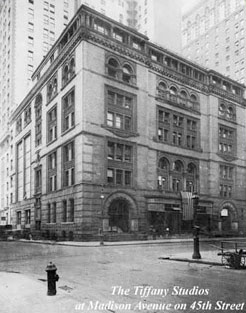 Tiffany Studios was an independent company formed in the 1890s. Prior to this, Tiffany had been working as a painter and interior decorator for about two decades under such names as L. C. Tiffany & Associated Artists, and Tiffany Glass & Decorating Company. Tiffany's work in art and decorative arts had led him to design windows and household decorations for special projects, the manufacture of which was usually contracted out. In the early 1890s, Tiffany decided to concentrate on the large scale production of stained glass windows, blown glass, lamps, and decorative household items for retail sale. Stained glass windows were almost always custom designed for a specific client, and while many of his other decorative items were stock pieces, some were made as special design orders.
Tiffany Studios was an independent company formed in the 1890s. Prior to this, Tiffany had been working as a painter and interior decorator for about two decades under such names as L. C. Tiffany & Associated Artists, and Tiffany Glass & Decorating Company. Tiffany's work in art and decorative arts had led him to design windows and household decorations for special projects, the manufacture of which was usually contracted out. In the early 1890s, Tiffany decided to concentrate on the large scale production of stained glass windows, blown glass, lamps, and decorative household items for retail sale. Stained glass windows were almost always custom designed for a specific client, and while many of his other decorative items were stock pieces, some were made as special design orders.
Tiffany's business began to fade just prior to World War I, and in 1917 Tiffany retired while allowing some of his employees to continue to sell wares as Tiffany Furnaces, though pieces were often made with parts long in stock that had already been marked Tiffany Studios or L. C. Tiffany. Tiffany died in 1932, his business bankrupt and liquidated.
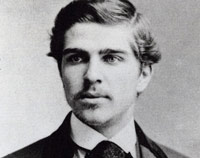 He began producing lamps after Thomas Edison suggested the idea during their collaboration on the electric lighting of the first movie theater, the Lyceum. But it's also believed that he began making lamps as a way to use up scraps from his window manufacturing business. Embracing the Art Nouveau style at the beginning of the 20th century, he instructed his craftsmen to create elaborate lamps to fit the new style.
He began producing lamps after Thomas Edison suggested the idea during their collaboration on the electric lighting of the first movie theater, the Lyceum. But it's also believed that he began making lamps as a way to use up scraps from his window manufacturing business. Embracing the Art Nouveau style at the beginning of the 20th century, he instructed his craftsmen to create elaborate lamps to fit the new style.
His lamps quickly became popular at home and abroad. Craftsmen set tiny pieces of glass in natural patterns, featuring flowers, butterflies, or dragonflies, while the bronze bases complemented the leaded shades. Later, some shades were made in folds from panels of pressed glass, creating the appearance of a tweedy fabric. Some of the original Tiffany's were gas, later converted into electric lighting.
